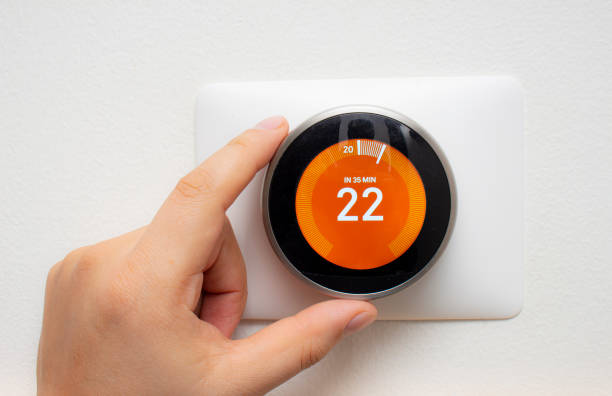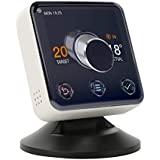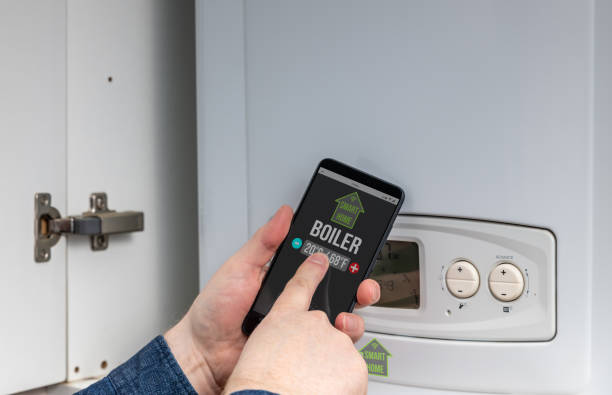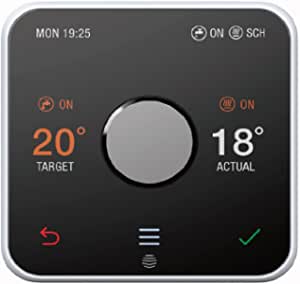Disclosure: Some of the links below are Amazon affiliate links. This means that, at no cost to you, we may earn an affiliate commission if you click through the link and complete a purchase.
If you’re looking to upgrade your home’s heating system, then you might be considering a smart thermostat. Two of the most popular options on the market are the Hive and Nest thermostats. Both offer a range of features designed to help you heat your home more efficiently, but they differ in some important ways. In this article, we’ll take a closer look at what each of these thermostats has to offer, so you can decide which one is right for you.

One of the key differences between the Hive and Nest thermostats is the way they learn about your heating habits. The Nest thermostat uses machine learning to identify patterns in your heating usage and create a personalized schedule that fits your lifestyle.
The Hive thermostat, on the other hand, relies on manual adjustments to learn your preferences. This means that you’ll need to spend some time adjusting the temperature and settings to get the most out of your Hive thermostat.
Another important factor to consider is the compatibility of each thermostat. The Nest thermostat works with a wide range of smart home devices, including Google Home and Amazon Alexa. This means that you can control your heating using your voice or through your smartphone, and you can integrate your thermostat with other smart home devices to create a fully connected home.
The Hive thermostat, on the other hand, is more limited in terms of its compatibility. It works with Amazon Alexa and Google Assistant, but it doesn’t have the same level of integration with other smart home devices as the Nest thermostat.
What is a Hive Thermostat?

Hive Active Heating is a smart thermostat that allows you to control your heating and hot water from your smartphone, tablet or computer. It is designed to make it easy for you to manage your home’s temperature, save energy and reduce your heating bills. The Hive app is available on iOS and Android, and it is simple to use.
The Hive thermostat has a range of features that make it stand out from other thermostats. It has multi-zone control, which means you can control the temperature in different rooms of your home. This is particularly useful if you have a large house or if some rooms are used more than others. You can also set up schedules and timers, so your heating and hot water come on when you need them and turn off when you don’t.
Another great feature of the Hive thermostat is that it is compatible with other smart home products, such as Amazon Echo and Google Home. This means you can control your heating with your voice, as well as with the Hive app. The Hive ecosystem also includes other products, such as remote cameras, window/door sensors, motion sensors, smart light bulbs, plug sockets and even a water leak sensor.
What is a Nest Thermostat?

The Nest Thermostat is a popular smart thermostat that can help you save money on your energy bills. It was first released in 2011 and has since undergone several updates and redesigns. The latest version, as of 2023, is the Nest Learning Thermostat (3rd generation).
The Nest Thermostat is designed to learn your heating and cooling preferences over time and create a personalized schedule that can help you save energy. It can also be controlled remotely using a smartphone app or voice commands through a smart speaker.
The Nest Thermostat has a sleek, modern design and a large, easy-to-read display. It can be installed by a professional or by the homeowner themselves, depending on their level of experience.
Here are some key features of the Nest Thermostat:
- Learning capability to create a personalized schedule
- Remote control via smartphone app or voice commands
- Compatibility with most heating systems
- Energy-saving features, such as Eco mode and Home/Away Assist
- Integration with other smart home devices, such as smart speakers and cameras
Overall, the Nest Thermostat is a reliable and user-friendly option for those looking to upgrade their home’s heating and cooling system with a smart thermostat.
Features of Hive Thermostat
Hive Active Heating is a smart thermostat that comes with a range of impressive features. Here are some of the key features of the Hive thermostat:
- Remote control: The Hive thermostat can be controlled remotely using the Hive app, which is available for iOS and Android devices. This means you can adjust the temperature of your home from anywhere, at any time.
- Integration with other smart home products: Hive is compatible with a range of other smart home products, including Amazon Alexa, Google Assistant, and Philips Hue. This means you can use voice commands to control your heating, or set up automated routines using other smart home devices.
- Multi-zones: If you have more than one heating zone in your home, you can use the Hive thermostat to control each zone independently. This means you can set different temperatures for different areas of your home, and only heat the rooms you’re using.
- Hot water control: The Hive thermostat can also be used to control your hot water system. You can set schedules for when you want hot water, or turn it on and off manually using the Hive app.
- Easy to use: Hive is known for its simplicity of operation. The thermostat has a clear, easy-to-read display, and can be controlled using the dial on the front of the device.
Overall, the Hive thermostat is a reliable, user-friendly device that offers a range of useful features. Whether you’re looking to save money on your energy bills, or simply want to make your home more comfortable, the Hive thermostat is definitely worth considering.

Features of Nest Thermostat
The Nest Thermostat is one of the most advanced smart thermostats available in the market. Here are some of the features that make it stand out:
- Auto-Schedule: The Nest Thermostat learns your schedule and temperature preferences and automatically adjusts the temperature accordingly. This means you don’t have to manually set the temperature every time you come home or leave.
- Remote Control: You can control your Nest Thermostat from anywhere using your smartphone or tablet. This means you can adjust the temperature even when you’re not at home.
- Energy-Saving Features: The Nest Thermostat helps you save energy by automatically turning off the heating or cooling when you’re not at home. It also provides energy reports to help you track your energy usage and identify areas where you can save energy.
- Compatibility with Other Devices: The Nest Thermostat is compatible with a wide range of other smart home devices, including Amazon Alexa, Google Assistant, and Philips Hue. This means you can control your thermostat using voice commands or integrate it with other smart home systems.
- Multi-Zone Control: If you have multiple Nest Thermostats installed in your home, you can control the temperature of each zone individually. This means you can set different temperatures for different rooms or areas of your home.
- Auto-Away: The Nest Thermostat uses sensors to detect when you’re not at home and automatically adjusts the temperature to save energy. It can also turn off the heating or cooling if it detects an open window or door.
Overall, the Nest Thermostat is a powerful and intuitive device that can help you save energy and make your home more comfortable. Its advanced features and compatibility with other smart home devices make it a great choice for anyone looking to upgrade their home’s heating and cooling system.
Comparison of Hive and Nest Thermostat
Both Hive and Nest thermostats are popular choices among homeowners for their smart features and energy-saving capabilities. Here is a brief comparison of the two:
| Features | Hive | Nest |
| Zones | 3 zones | Up to 20 zones |
| Compatibility | Works with most boilers, but not all | Works with most boilers, but not all |
| Design | Simple and minimalistic | Modern and sleek |
| Learning | Does not have learning capabilities | Has learning capabilities |
| App | Easy to use, but lacks some features | Offers more features and customization |
When it comes to zone support, the Nest thermostat offers up to 20 zones, which can be accessed by up to 10 different devices. In comparison, the Hive only offers up to 3 zones. This makes Nest a better option for larger homes with multiple rooms.
Both thermostats are compatible with most boilers, but not all. It is important to check compatibility before purchasing either of them.
In terms of design, the Hive thermostat has a simple and minimalistic design, while the Nest thermostat has a modern and sleek design. The Nest thermostat also has learning capabilities, which means it can learn your schedule and adjust the temperature accordingly. The Hive thermostat does not have this feature.
Both thermostats have their own apps for easy control and customisation. However, the Nest app offers more features and customization options compared to the Hive app, which is relatively simple and lacks some features.
Overall, both the Hive and Nest thermostats are good options for homeowners looking for a smart thermostat with energy-saving capabilities. The choice between the two ultimately depends on personal preference and the specific needs of your home.
Which is Better? Hive or Nest Thermostat?
Here are some key differences to consider:
- Design: Both thermostats have a modern and sleek design, but the Hive thermostat has a more traditional look with a circular dial and buttons, while the Nest thermostat has a more futuristic look with a touch screen display.
- Learning capabilities: The Nest thermostat has learning capabilities, meaning it can learn your temperature preferences and adjust accordingly without you having to manually make changes. The Hive thermostat does not have this feature.
- Compatibility: Nest is compatible with more types of boilers and has more features than the Hive smart thermostat option. In addition, you can get a Nest included in the cost of a boiler with Boiler Central if you are considering a new boiler installation.
- Price: The Hive thermostat is generally more affordable than the Nest thermostat, making it a good option for those on a budget.
Overall, both the Hive and Nest thermostats are great options for those looking to upgrade to a smart thermostat. It ultimately comes down to personal preference and what features are most important to you.
Conclusion
After comparing Hive and Nest thermostats across various factors like design, installation, features, and others, it’s clear that both are popular, reliable, and useful in helping you gain better control of your home heating and energy bills. Ultimately, the choice between the two comes down to personal preference and specific needs.
If you’re looking for a thermostat that is more customizable and offers a wider range of features, Nest may be the better option. On the other hand, if you prefer a simpler interface and want a thermostat that integrates seamlessly with other Hive products, then Hive may be the way to go.
It’s also worth noting that both Hive and Nest offer smart home integration, allowing you to control your thermostat remotely through your smartphone or voice assistant. Additionally, both thermostats can learn your heating preferences and adjust accordingly, helping to save energy and reduce your bills.
Overall, whether you choose Hive or Nest, you can be confident that you’re getting a quality smart thermostat that can help you achieve greater control and efficiency in your home heating.

